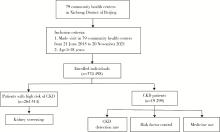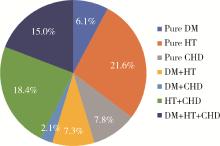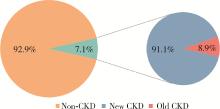Journal of Peking University (Health Sciences) ›› 2022, Vol. 54 ›› Issue (5): 1056-封三. doi: 10.19723/j.issn.1671-167X.2022.05.036
Chronic kidney disease in community: Current state for screening and management
Ling-yi XU1,2,Miao HUI1,2,Shu-hong ZHU2,3,Zhao YANG1,2,Meng-rui LI1,2,Hong-yu YANG1,2,Xi-zi ZHENG1,2,Ji-cheng LV1,2,*( ),Li YANG1,2,*(
),Li YANG1,2,*( )
)
- 1. Renal Division, Peking University First Hospital; Institute of Nephrology, Peking University; Key Laboratory of Renal Disease, Ministry of Health of China; Key Laboratory of CKD Prevention and Treatment, Ministry of Education of China; Research Units of Diagnosis and Treatment of Immune-Mediated Kidney Diseases, Chinese Academy of Medical Sciences; Beijing 100034, China
2. Joint Laboratory of Community Intelligent Health Management, Beijing 10034, China
3. Health Intelligence Research Center of Beijing Xicheng District, Beijing 100053, China
CLC Number:
- R692
| 1 |
Zhang L , Wang F , Wang L , et al. Prevalence of chronic kidney disease in China: A cross-sectional survey[J]. Lancet, 2012, 379 (9818): 815- 822.
doi: 10.1016/S0140-6736(12)60033-6 |
| 2 |
Zhang L , Long J , Jiang W , et al. Trends in chronic kidney disease in China[J]. N Engl J Med, 2016, 375 (9): 905- 906.
doi: 10.1056/NEJMc1602469 |
| 3 |
Coresh J , Selvin E , Stevens L A , et al. Prevalence of chronic kidney disease in the United States[J]. JAMA, 2007, 298 (17): 2038- 2047.
doi: 10.1001/jama.298.17.2038 |
| 4 | 北京统计局. 北京区域统计年鉴2021[M]. 北京: 中国统计出版社, 2021: 9- 12. |
| 5 |
Levey AS , Stevens LA , Schmid CH , et al. A new equation to estimate glomerular filtration rate[J]. Ann Intern Med, 2009, 150 (9): 604- 612.
doi: 10.7326/0003-4819-150-9-200905050-00006 |
| 6 |
Shlipak MG , Tummalapalli SL , Boulware LE , et al. The case for early identification and intervention of chronic kidney disease: Conclusions from a kidney disease: Improving global outcomes (KDIGO) controversies conference[J]. Kidney Int, 2021, 99 (1): 34- 47.
doi: 10.1016/j.kint.2020.10.012 |
| 7 |
Kidney disease: Improving global outcomes (KDIGO) CKD work group . KDIGO 2012 clinical practice guideline for the evaluation and management of chronic kidney disease[J]. Kidney Int Suppl, 2013, 3 (1): 1- 150.
doi: 10.1038/kisup.2012.73 |
| 8 |
上海市肾内科临床质量控制中心专家组. 慢性肾脏病早期筛查, 诊断及防治指南(2022年版)[J]. 中华肾脏病杂志, 2022, 38 (5): 453- 464.
doi: 10.3760/cma.j.cn441217-20210819-00067 |
| 9 |
董婷, 李建中, 吴声, 等. 苏州社区老年人慢性肾脏病筛查及共病分析[J]. 中华老年医学杂志, 2021, 40 (12): 1583- 1588.
doi: 10.3760/cma.j.issn.0254-9026.2021.12.023 |
| 10 | 林雅慧, 刘玉红, 王宓, 等. 社区高危人群慢性肾脏病患病率及筛查策略研究[J]. 中国实用内科杂志, 2018, 38 (12): 1169- 1172. |
| 11 |
Lv J , Ehteshami P , Sarnak MJ , et al. Effects of intensive blood pressure lowering on the progression of chronic kidney disease: A systematic review and meta-analysis[J]. CMAJ, 2013, 185 (11): 949- 957.
doi: 10.1503/cmaj.121468 |
| 12 |
Perkovic V , Heerspink HL , Chalmers J , et al. Intensive glucose control improves kidney outcomes in patients with type 2 diabetes[J]. Kidney Int, 2013, 83 (3): 517- 523.
doi: 10.1038/ki.2012.401 |
| 13 | 牛娜, 董建琴, 杜雪平. 北京市基层全科医生对慢性肾脏病的认知调查[J]. 中国全科学, 2017, 20 (10): 1267- 1270. |
| 14 | 赵慧颖, 黄雯, 张国娟. 各级医院非肾脏病科医生对慢性肾脏病知晓率的调查分析[J]. 中国血液净化杂, 2017, 16 (2): 100- 103. |
| 15 |
Rayner HC , Baharani J , Dasgupta I , et al. Does community-wide chronic kidney disease management improve patient outcomes?[J]. Nephrol Dial Transplant, 2014, 29 (3): 644- 649.
doi: 10.1093/ndt/gft486 |
| 16 |
蒙陆丹, 潘松球. 社区早期肾脏病筛查现状研究[J]. 中国社区医师, 2020, 36 (28): 7- 8.
doi: 10.3969/j.issn.1007-614x.2020.28.003 |
| 17 |
Conway N , Adamson KA , Cunningham SG , et al. Decision support for diabetes in Scotland: Implementation and evaluation of a clinical decision support system[J]. J Diabetes Sci Technol, 2018, 12 (2): 381- 388.
doi: 10.1177/1932296817729489 |
| 18 |
李小玲, 贾楠, 杨长贵, 等. 临床决策支持系统辅助社区高血压患者管理的效果研究[J]. 中国循环杂志, 2019, 34 (5): 481- 485.
doi: 10.3969/j.issn.1000-3614.2019.05.011 |
| [1] | Huichao MA,Jun LI,Yongqing WANG. Clinical characteristics of pregnancy complicated with inflammatory bowel disease [J]. Journal of Peking University (Health Sciences), 2024, 56(2): 260-266. |
| [2] | Lin MA,Jing-yi WU,Shuang-cheng LI,Peng-fei LI,Lu-xia ZHANG. Effect of modification of antihypertensive medications on the association of nitrogen dioxide long-term exposure and chronic kidney disease [J]. Journal of Peking University (Health Sciences), 2022, 54(5): 1047-1055. |
| [3] | Xiao-wei XIE,Fen LI,Guang-hui LING,Xi XIE,Su-qing XU,Yi-yue CHEN. Development and clinical application of the health education knowledge assessment questionnaire for gout [J]. Journal of Peking University (Health Sciences), 2022, 54(4): 699-704. |
| [4] | YANG Chao, WANG Jin-wei, YANG Yao-zheng, BAI Kun-hao, GAO Bi-xia, ZHAO Ming-hui, ZHANG Lu-xia, WU Shou-ling, WANG Fang. Impact of anemia and chronic kidney disease on the risk of cardiovascular disease and all-cause mortality among diabetic patients [J]. Journal of Peking University(Health Sciences), 2018, 50(3): 495-500. |
| [5] | LIN Hong-bo, CHEN Yi, SHEN Peng, LI Xiao-yong,SI Ya-qin, ZHANG Du-dan, TANG Xun, GAO Pei. Incidence and risk factors of chronic kidney disease in community-based patients with diabetes [J]. Journal of Peking University(Health Sciences), 2018, 50(3): 416-421. |
| [6] | SUN Xin-ying;GUO Yan;SUN Jing . Validation of the integration of health belief model and planned behavior theory [J]. Journal of Peking University(Health Sciences), 2009, 41(2): 129-134. |
|
||





